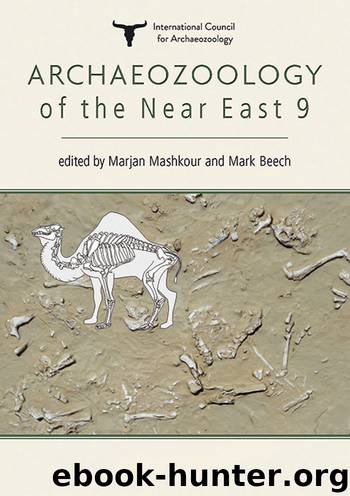Archaeozoology of the Near East by Mashkour Marjan; Beech Mark;

Author:Mashkour, Marjan; Beech, Mark;
Language: eng
Format: epub
Publisher: Oxbow Books
Published: 2017-03-19T16:00:00+00:00
In terms of the general taphonomy, over 90% of specimens recovered from ‘Atij, Raqa’i, and Ziyadeh were removed from general refuse deposits, although no true middens or distinct trash heaps or pits of any significant size were recorded. As is typical for Middle Eastern sites, most of the assemblage for these three sites accrued as general deposition in areas of the community that were not dedicated to specific activities but which were adjacent to inhabited spaces and therefore convenient for receiving daily household waste, such as abandoned buildings and little-used open areas between structures. In the case of Gudeda, a much smaller proportion of the sample (50%) represents these general discard deposits. Most of the remaining half comes from contexts that have been coded as primary accumulation, material identified by the excavators as resting immediately above floors and occupation surfaces. These may represent nothing other than the initial deposits amassed in unused and decaying structures, however, rather than genuine primary contexts that reflect behaviours that occurred on the ancient surface while it was still in active use. The former situation is more probable, in fact, as few if any of these strata are sealed deposits – no significant upper bounding surfaces, such as collapse from a conflagration or other catastrophic event, were identified. This being the case, the Gudeda sample is therefore likely comparable in overall archaeological context to the other three sites, and eventual examination of the Gudeda material broken down by context should confirm if this is the situation or not.
Only the faunal material from Raqa’i was recovered through use of a consistent hand-screening regimen, but several taphonomic indices reveal that the bias introduced by the lack of standard screening at the other sites is minimal (Rufolo 2011, 271–273). As the assemblages vary considerably in number of specimens, the greater concern is that any differences in species composition or taxonomic abundance observed among the sites may more closely reflect bias due to the disparity in sample size rather than any true differences at the population level. Minimum number of individual (MNI) counts, which are free of the problem of statistical interdependence presented by number of identified specimen (NISP) figures (Grayson 1984, 17–49), were calculated for each site in the hope that a chi-square test could be performed to reveal the presence of statistically significant variations in assemblage composition based upon sample size. Unfortunately, the MNI numbers are too small to meet all the requirements for the test to be valid, specifically failing to possess a low enough percentage of expected frequencies that fall below a value of 5 in the contingency table calculated as part of the test. A basic assessment of sample-size bias was still possible employing the raw NISP data rather than MNI counts. A linear regression using the log-transformed values of the NISP figures for the total number of specimens identified to the taxonomic rank of genus for each of the four sites was run against the number of confirmed genera present for each assemblage (Fig.
Download
This site does not store any files on its server. We only index and link to content provided by other sites. Please contact the content providers to delete copyright contents if any and email us, we'll remove relevant links or contents immediately.
| Africa | Americas |
| Arctic & Antarctica | Asia |
| Australia & Oceania | Europe |
| Middle East | Russia |
| United States | World |
| Ancient Civilizations | Military |
| Historical Study & Educational Resources |
The Daily Stoic by Holiday Ryan & Hanselman Stephen(3178)
The Fate of Rome: Climate, Disease, and the End of an Empire (The Princeton History of the Ancient World) by Kyle Harper(2959)
People of the Earth: An Introduction to World Prehistory by Dr. Brian Fagan & Nadia Durrani(2662)
Ancient Worlds by Michael Scott(2560)
Babylon's Ark by Lawrence Anthony(2475)
The Daily Stoic by Ryan Holiday & Stephen Hanselman(2405)
Foreign Devils on the Silk Road: The Search for the Lost Treasures of Central Asia by Peter Hopkirk(2396)
India's Ancient Past by R.S. Sharma(2349)
MOSES THE EGYPTIAN by Jan Assmann(2328)
The Complete Dead Sea Scrolls in English (7th Edition) (Penguin Classics) by Geza Vermes(2187)
Lost Technologies of Ancient Egypt by Christopher Dunn(2159)
The Earth Chronicles Handbook by Zecharia Sitchin(2136)
24 Hours in Ancient Rome by Philip Matyszak(2011)
Alexander the Great by Philip Freeman(1995)
Aztec by Gary Jennings(1914)
The Nine Waves of Creation by Carl Johan Calleman(1824)
Curse Tablets and Binding Spells from the Ancient World by Gager John G.;(1801)
Before Atlantis by Frank Joseph(1774)
Earthmare: The Lost Book of Wars by Cergat(1749)
